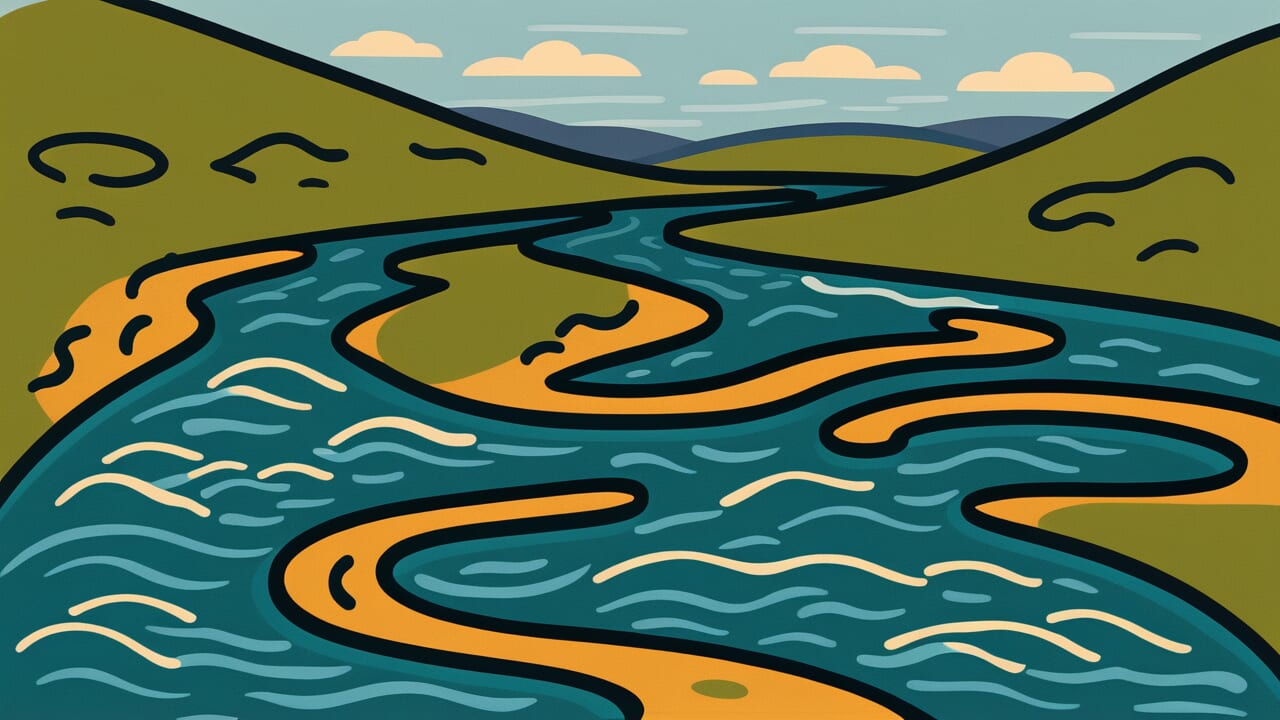How to Read “A river can reach far because it winds and bends”
Kawa wa ija wo motte no yue ni yoku tōshi
Meaning of “A river can reach far because it winds and bends”
This proverb means that flexibility and willingness to bend allow you to go far. Just as a river flows around rocks and terrain without fighting them, eventually reaching the distant sea, people who adapt flexibly to situations rather than stubbornly sticking to one method can ultimately achieve their goals.
People use this proverb when facing difficulties or when things don’t go according to plan. It reminds us not to force our way through obstacles head-on. Sometimes taking a detour or changing methods is the wiser choice.
In modern times, this saying appears in business and relationship contexts to emphasize flexible attitudes. It warns that stubbornness and inflexibility lead to failure. The proverb teaches that graceful adaptability is the true path to success.
Origin and Etymology
This proverb likely comes from the ancient Chinese text “Xunzi,” specifically from the chapter called “Youzuo.” The original text uses the phrase “A river can reach far because it winds and bends” to teach life wisdom through the nature of flowing water.
The term “ija” (委蛇) is an old expression describing something that moves in a winding, curving manner. Rivers never flow in straight lines. They don’t fight the terrain. When they meet rocks, they go around. When they find valleys, they follow along.
This flexible approach is the secret that allows rivers to reach far distances. The proverb was born from this observation.
In ancient China, philosophers developed the idea of learning how to live by observing natural phenomena. Water’s properties were especially valued. Laozi’s famous saying “The highest good is like water” shows how water symbolized the ideal way of being.
Water is soft and changes shape. It avoids obstacles yet always reaches its destination: the sea.
This proverb captures water’s wisdom in concentrated form. It traveled to Japan and has been passed down as life guidance. The saying contains a deep insight: moving straight ahead isn’t always the right path.
Usage Examples
- Following the spirit of “A river can reach far because it winds and bends,” he re-proposed his rejected project from a different angle and succeeded
- Don’t dwell on this failure. Like “A river can reach far because it winds and bends,” let’s try a different approach
Universal Wisdom
This proverb has been passed down for thousands of years because it recognizes both human weakness and strength. We humans tend to cling to our beliefs and methods. We often feel that changing our chosen path means “losing.” We mistake flexible responses for “weakness.”
But look at the natural world. The strongest don’t always survive. The most adaptable do. Rivers are among Earth’s oldest natural phenomena. Their secret is that they never try to force their way through.
When a river meets a rock obstacle, it either erodes it over tens of thousands of years or goes around it. The river changes its response based on the situation.
Life works the same way. When moving toward a goal, we often convince ourselves “this is the only way.” But there’s never just one path. In fact, clinging to a single path can sometimes take us further from our intended destination.
Our ancestors observed flowing rivers and realized this deep truth. Flexibility isn’t weakness. It’s actually the strongest survival strategy. They left us this proverb to pass that wisdom to future generations.
When AI Hears This
River meandering actually results from water naturally choosing the path that wastes the least energy. Imagine a straight river. Water rushes forward in a direct line, but it violently erodes the riverbed and banks, losing massive amounts of energy to friction.
In a meandering river, flow velocity differs between the outside and inside of curves. This velocity difference gradually disperses the water’s kinetic energy. The river avoids sudden energy release and travels long distances gently.
What’s fascinating is that this meandering pattern is mathematically predictable. River engineering research shows that natural river meander wavelengths tend to be about 10 to 14 times the river width. This isn’t coincidence. It’s the optimal solution that minimizes energy dissipation rate.
Even when rivers are artificially straightened, they begin meandering again over time. This happens because water itself seeks out the most energy-efficient form.
The same principle applies to human effort. Charging straight toward a goal means losing large amounts of energy with each obstacle. But advancing flexibly with detours allows you to reach far distances with sustainable power, even if it seems like a longer route.
Physical laws teach us this truth: the shortest distance isn’t always the optimal solution.
Lessons for Today
Modern society emphasizes speed and efficiency so much that we tend to seek linear success. But this proverb offers us a different perspective. If you’re hitting a wall right now, maybe it’s time to change direction.
In careers and relationships alike, sticking to one method sometimes narrows our vision. Some people view frequent job changes negatively as “lacking direction.” But it might be like a river bending as it flows. What matters is the ultimate direction you’re heading.
When we fail, we tend to blame ourselves. But rivers don’t consider hitting a rock a failure. They simply look for another path. Your life is the same. Things not going according to plan isn’t failure. It’s a chance to find a better way.
Being flexible doesn’t mean lacking conviction. It means holding the goal of reaching the sea while knowing there are countless paths to get there. That’s the most important wisdom this proverb teaches us who live in modern times.



Comments